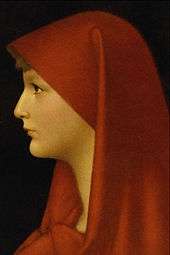Saint Fabiola
| Saint Fabiola | |
|---|---|
|
Copy of Henner's portrait of St. Fabiola. | |
| Born | Rome, Italy |
| Died | 399 |
| Venerated in | Roman Catholic Church |
| Canonized | Pre-Congregation |
| Feast | 27 December |
| Patronage | Divorced people, difficult marriages, victims of abuse; adultery; unfaithfulness, widows; Hospice Movement |
Saint Fabiola was a nurse (physician) and Roman matron of rank of the company of noble Roman women who, under the influence of the Church father St. Jerome gave up all earthly pleasures and devoted themselves to the practice of Christian asceticism and charitable work.[1]
Early life
Fabiola belonged to the patrician Roman family of the gens Fabia. She had been married to a man who led so vicious a life that to live with him was impossible. She obtained a divorce from him according to Roman law and, contrary to the ordinances of the Church, she entered upon a second union before the death of her first husband.[1]
At the time of St. Jerome's stay at Rome (382-84), Fabiola was not one of the ascetic circle which gathered around him. It was only later that, upon the death of her second consort, she decided to enter upon a life of renunciation and labour for others. On the day before Easter, following the death of her second consort, she appeared before the gates of the Lateran basilica, dressed in penitential garb, and did public penance for her sin, which made a great impression upon the Christian population of Rome. The pope received her formally again into full communion with the Church.[1]
Conversion to Christianity and later life
Fabiola now renounced all that the world had to offer her, and devoted her immense wealth to the needs of the poor and the sick. She erected a fine hospital at Rome, and waited on the inmates herself, and treated citizens rejected from society due to their "loathsome diseases". Besides this she gave large sums to the churches and religious communities at Rome and other places in Italy. All her interests were centered on the needs of the Church and the care of the poor and suffering.[1]
In 395 she went to Bethlehem, where she lived in the hospice of the convent directed by Saint Paula and applied herself, under the direction of St. Jerome, with the greatest zeal to the study and contemplation of the Scriptures and to ascetic exercises. An incursion of the Huns into the eastern provinces of the empire and the quarrel which broke out between Jerome and John II, Bishop of Jerusalem respecting the teachings of Origen made residence in Bethlehem unpleasant for her and she returned to Rome.[1]
She remained, however, in correspondence with St. Jerome, who at her request wrote a treatise on the priesthood of Aaron and the priestly dress. At Rome, Fabiola united with the former senator Saint Pammachius in carrying out a great charitable undertaking; together they erected at Portus a large hospice for pilgrims coming to Rome. Fabiola also continued her usual personal labours in aid of the poor and sick until her death on 27 December of 399 or 400. Although Fabiola's practice of medicine was pragmatic in application, her legacy illustrates the involvement of early Christian women in the field of medicine.[2]
Veneration and Legacy
Her funeral was a wonderful manifestation of the gratitude and veneration with which she was regarded by the Roman populace.
St. Jerome wrote a eulogistic memoir of Fabiola in a letter to her relative Oceanus.[1]
Jean-Jacques Henner painted his portrait of Fabiola (in a classical Roman profile) in 1885; this idealized rendition of the saint was lost in 1912. The image was copied by artists around the globe over the last century, in 2009 Francis Alÿs composed a traveling exhibition of over 300 of these copies. The exhibit first ran at the Hispanic Society of America in New York City, then the LACMA in Los Angeles, with the exhibition going to London at the National Portrait Gallery from May to September 2009. The collection, grown to include 514 copies of the portrait, is on exhibit at the Byzantine Fresco Chapel of the Menil Collection in Houston from May 21, 2016 - May 13, 2018.
References
- 1 2 3 4 5 6 Herbermann, Charles (1909). The Catholic Encyclopedia: An International Work of Reference on the Constitution, Doctrine, Discipline, and History of the Catholic Church. Robert Appleton.
- ↑ Ogilvie, Marilyn Bailey (1986). Women in Science: antiquity though the 19th century. Massachusetts Institute of Technology. ISBN 0-262-15031-X.
External links
![]() This article incorporates text from a publication now in the public domain: Herbermann, Charles, ed. (1913). "article name needed". Catholic Encyclopedia. New York: Robert Appleton.
This article incorporates text from a publication now in the public domain: Herbermann, Charles, ed. (1913). "article name needed". Catholic Encyclopedia. New York: Robert Appleton.
